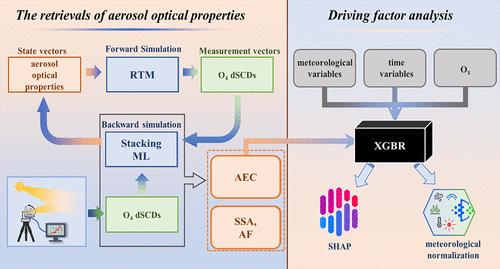探索气溶胶垂直分布及其影响因素:来自MAX-DOAS和机器学习的见解
IF 11.3
1区 环境科学与生态学
Q1 ENGINEERING, ENVIRONMENTAL
引用次数: 0
摘要
了解气溶胶垂直分布对缓解气溶胶污染至关重要,但由于观测数据有限而受到阻碍。本研究采用多轴差分光学吸收光谱(MAX-DOAS)技术,结合辐射传输模型-机器学习(RTM-ML)耦合框架,反演上海地区高分辨率气溶胶光学特性。反演结果表明气溶胶垂直减少,夏季在高层大气达到峰值,冬季在低层大气达到峰值。气溶胶吸湿性具有相似的季节特征,但随海拔升高而增加。采用多因素驱动ML模型和Shapley加性解释(SHAP)研究气溶胶变化的驱动因素。结果表明,排放、东西输运和大气氧化是0.5 km以下气溶胶的主要驱动因素。0.5 km以上以湿度和大气氧化为主,表明吸湿生长和二次气溶胶形成更为突出。南北输送对0.5 ~ 1.6 km范围内的气溶胶分布也有显著影响。气象规范化强调,减排可以有效降低低层大气中的气溶胶,而大气氧化的增强促进了次生气溶胶的形成,特别是在高层大气中。这些发现促进了对形成垂直气溶胶分布的多个因素的理解,并强调了解决复合污染的减排策略应该以多维和多因素的理解来构思。本文章由计算机程序翻译,如有差异,请以英文原文为准。

Exploring Aerosol Vertical Distributions and Their Influencing Factors: Insight from MAX-DOAS and Machine Learning
Understanding aerosol vertical distribution is crucial for aerosol pollution mitigation but is hindered by limited observational data. This study employed multiaxis differential optical absorption spectroscopy (MAX-DOAS) technology with a coupled radiative transfer model-machine learning (RTM-ML) framework to retrieve high-resolution aerosol optical properties in Shanghai. Retrievals indicated vertically decreasing aerosols, peaking in the upper atmosphere in the summer and in the lower atmosphere in the winter. Aerosol hygroscopicity followed similar seasonal patterns but increased with the altitude. Multifactor driving ML models and Shapley additive explanations (SHAP) were used to investigate the drivers to aerosol variation. Results indicated that emissions, east–west transport, and atmospheric oxidation were the main drivers of aerosols below 0.5 km. Above 0.5 km, humidity and atmospheric oxidation became dominant, suggesting that hygroscopic growth and secondary aerosol formation were more prominent. North–south transport also significantly influenced aerosol distribution within 0.5 to 1.6 km. Meteorological normalization emphasized that emission reduction can effectively lower aerosols in the lower atmosphere, while enhanced atmospheric oxidation promoted secondary aerosol formation, particularly in the upper atmosphere. These findings advance the understanding of multiple factors in shaping the vertical aerosol distributions and highlight that emission reduction strategies for addressing compound pollution should be conceived with a multidimensional and multifactorial understanding.
求助全文
通过发布文献求助,成功后即可免费获取论文全文。
去求助
来源期刊

环境科学与技术
环境科学-工程:环境
CiteScore
17.50
自引率
9.60%
发文量
12359
审稿时长
2.8 months
期刊介绍:
Environmental Science & Technology (ES&T) is a co-sponsored academic and technical magazine by the Hubei Provincial Environmental Protection Bureau and the Hubei Provincial Academy of Environmental Sciences.
Environmental Science & Technology (ES&T) holds the status of Chinese core journals, scientific papers source journals of China, Chinese Science Citation Database source journals, and Chinese Academic Journal Comprehensive Evaluation Database source journals. This publication focuses on the academic field of environmental protection, featuring articles related to environmental protection and technical advancements.
 求助内容:
求助内容: 应助结果提醒方式:
应助结果提醒方式:


